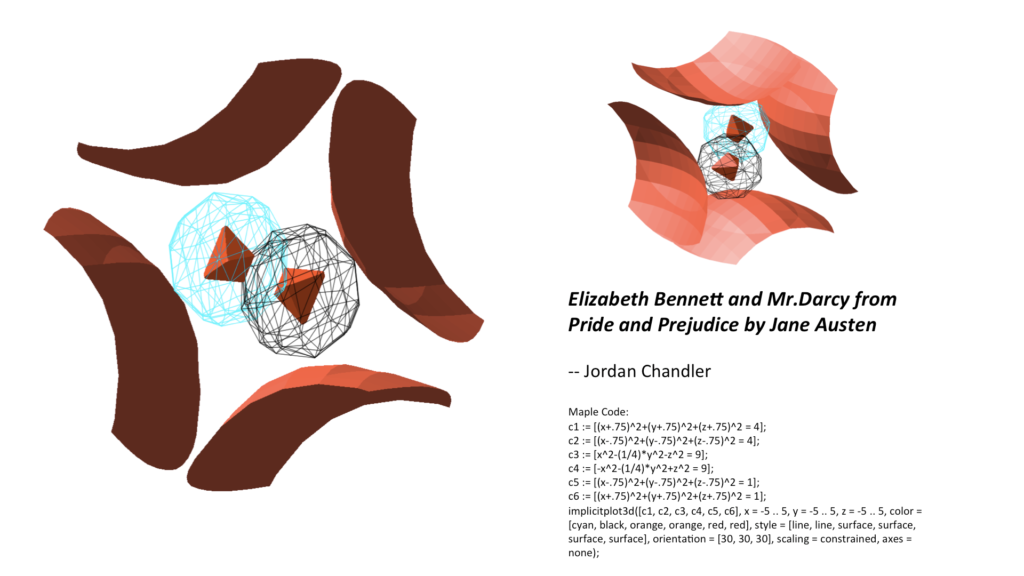Take a look around inside the Weltner Library this semester and you’ll see the work of Professor Mary Garner’s fall 2018 Calculus III students on display—an assignment that combined math, art, and literature.
Using the mathematical program Maple, the budding mathematicians were asked to create a three-dimensional object that paid homage to their favorite character from literature. The students were required to use at least three different quadric surfaces and specify the equations for those surfaces in their Maple code.
The assignment echoed the work of Man Ray (1890-1976), an American visual artist who spent much of his life in Paris. In the 1930s, Man Ray visited the Institute Henri Poincare, a school for higher mathematics in Paris, where he photographed models representing various mathematic equations. He later converted those photos to oil paintings. Finding the images suggested Shakespearean characters, he named the series “Shakespearean Equations.”
“I firmly believe that you need to play with the mathematics you’re studying,” said Professor Garner. “This assignment gave the students a chance to play with the equations and the shapes they produce, discovering how the parameters of each equation influence the shape. At the same time, I wanted them to learn about Man Ray and see one example of how artists who are not mathematicians can find mathematics fascinating.”
Professor Garner believes strongly in the value of making connections between seemingly disparate disciplines of math, art, and literature.
“It seems that people take it for granted that in art and literature you first form an idea, a theory, and then communicate that idea through your skill in creating a work of art,” she commented. “In mathematics, most people experience a blind skill practice without enough emphasis on the ideas that you’re communicating through mathematics. So, I guess I see the three as the same thing… just communicating ideas differently.”
The students’ creations ranged from classic (Dracula) to modern day interpretations (Sponge Bob Squarepants).
The students in the class were: Benedict Kargbo, Caleb Orji, Jordan Chandler, Manuel Quintal Correia, Kaebron Aschalew, Tim Moore, Kristoff Dixon, Nathan Lee, Taylor Turner, Mason Rodericks, NaShea Kendrick, Cameron Crowe, Peyton Leonard, Jordan Dennis, Nicholas Plaza Alvarez, Jiaya Yu, Chelsea Russell, Ivan Gallegos-Casillas, Mufaro Guzha, Jack Brand, Richard McMillan, and Will Rogers.
Jordan Chandler modeled “Elizabeth Bennett and Mr. Darcy from Pride and Prejudice by Jane Austen,” outlining her choices thusly:
“The circles represent the two characters. Both are well rounded, and guarded by fence-like barriers to keep people at a distance. The cyan circle represents Elizabeth. The color is meant to show her vibrancy, and the way she stands out from others. The black circle is Mr. Darcy. He is tough and cold on the outside. In many ways they are different, but there are still parts of them that overlap which is why the circles do too.”

Elizabeth Bennett and Mr. Darcy
